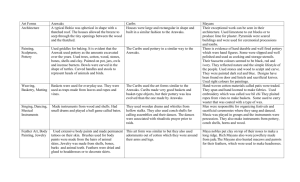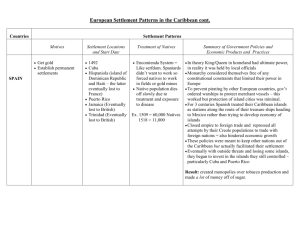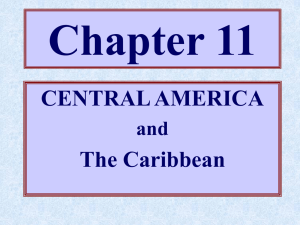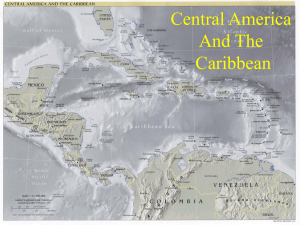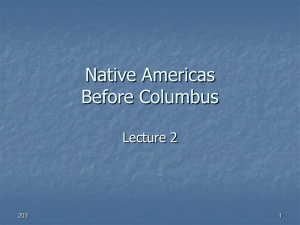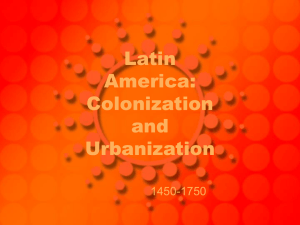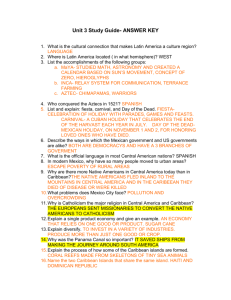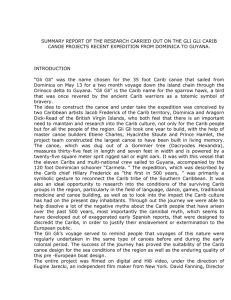The Myth of Cannibalism and Warlike Caribs.
advertisement
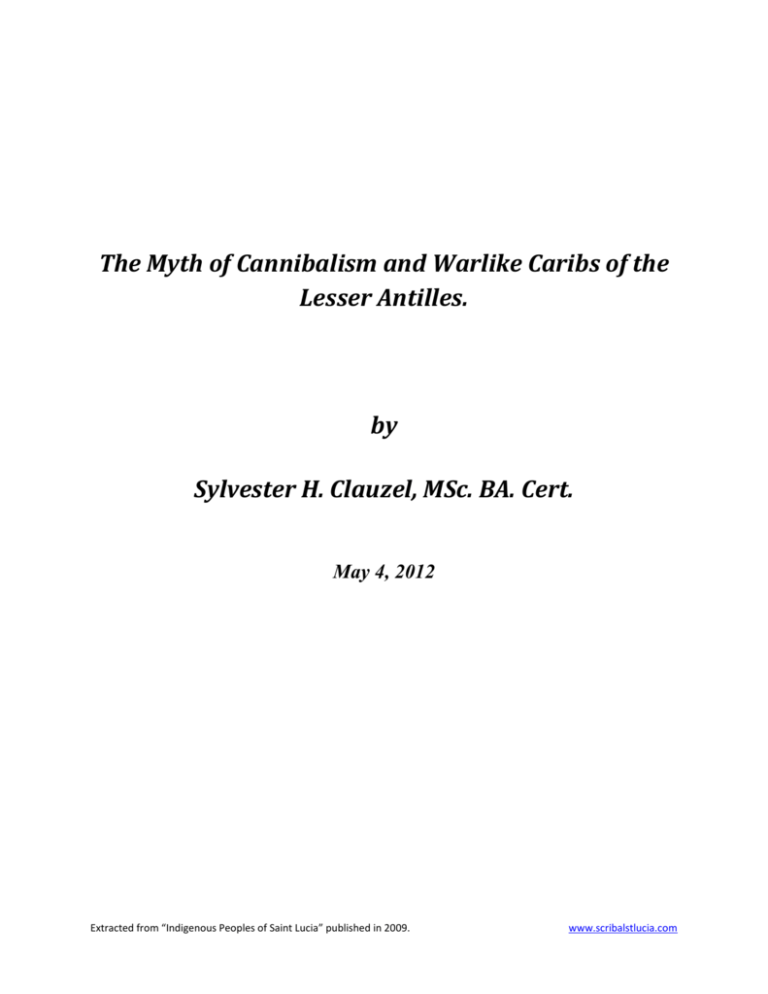
The Myth of Cannibalism and Warlike Caribs of the Lesser Antilles. by Sylvester H. Clauzel, MSc. BA. Cert. May 4, 2012 Extracted from “Indigenous Peoples of Saint Lucia” published in 2009. www.scribalstlucia.com PREAMBLE The purpose of this presentation is not really to challenge what has been described as “cannibalism and warlike Caribs”. Although important, that is only my secondary objective. Rather, my primary objective it is to encourage our modern researchers and academics to do precisely what the keynote speaker at the opening session of this academic conference, Dr. Didacus Jules said: that is to “re-think and re-value traditional knowledge” and to be critical about received information from sources which may have ulterior motives or bias intensions. My primary objective therefore, is to keep faith with the motto of this academic conference and contribute towards sharing information that can support sustainable development, otherwise the history that we tell our children is largely devoid of anything worth learning from, and consequently, as the dictum goes, we be will forced to repeat this pointless history. Our history does not edify us! It is captured in a way that reinforces negative attributes of our history, to include our enslavement; our liberation engineered by other people and not ourselves; our laziness and refusal to work so we had to be replaced by other more willing workers; we were exploited by those who were smarter than us and then given independence under the guise of self determination but it was only because we were no longer of any use to the colonizing powers; and to compound the issue, we could not tell the difference. And finally to the point of my thesis, that our indigenous ancestors were unconscientiously warlike and ate the bodies of their captured enemies. INTRODUCTION St. Lucia is situated half-way up the chain of islands that form the Eastern Caribbean. European Historians tell us that man-eating savages called “Caribs” inhabited these islands and moved from island to island, plundering the villages and stealing the women of the more peaceful Arawaks. They argue that by the time Columbus arrived in 1492, the Arawaks had been confined to the Greater Antilles and that the “Caribs”, having dominated the Lesser Antilles, were challenging the Arawaks on the island of Puerto Rico. These and many other stories about the indigenous inhabitants of the islands of the Caribbean have been perpetuated for centuries and continue to be taught in our schools. 2 It is important to commence this discourse by dispelling some basic untruths. The indigenous peoples of the Lesser Antilles did not call themselves “Carib”. The living descendants of the people we call “Caribs” on the island of Dominica say “Nou sé Kalinago – We are the Kalinago people”. In fact to be more precise, the men were called Kalinago and the women Kallipuna. But for the purposes of this presentation, the term Kalinago will be used to describe this group. They were the second set of a large migrant group of the Arawakan-speaking peoples, identified by Archaeologists as of the Saladoid group, who came to what we now call the Caribbean Islands from South America between 500 and 1000 A.D. SALADOID MIGRANTS The Saladoid people have been distinguished by the material culture or artefacts they left behind, and which archaeologists use to interpret and describe them. They are named after the Venezuela archaeological site of Saladero noted for its ceramics decorated with white and red painting, and the distinctive zone-incised crosshatching, seen in many rock-carvings and on ceramics. THE TAINO The Saladoid people are believed to have come in two, or perhaps three distinct groups. The first group began their journey from the mouth of the Orinoco River around 500 BC. This group later emerged into what has been described as the Taino, who dominated the Greater Antillean islands of Puerto Rico and Hispaniola by the time of the arrival of the Europeans around 1500 AD. THE KALINAGO The second Saladoid group began their movement around 600 AD. This group was called the Kalinago. They were not raiders and savages or “Caribs”, as many Historians have described them, but traders who also settled in the islands. Some Archaeologists and Historians claim that there was a third movement, which began around 1000 AD. This group has been described as the warlike savage group who chased the Arawaks up the chain of islands. This research suggests that this group were largely traders, but also of the Kalinago group. It is believed that the Kalinago called their traders “Kaniba”. Nancie Gonzalez (Sojourners of the Caribbean, 1988:171) suggests that this trade may have emerged from the demand for volcanic rock found in abundance on the islands, and which provided excellent material for making tools. She argues 3 further that cassava bread would have been welcomed by indigenous settlements in the Orinoco delta, where manioc, the root crop used to make cassava bread, grew either poorly or not at all. This initial entrance into the islands based on demand, would soon translate into supply. It is now widely believed by scholars studying Caribbean pre-Columbian peoples, that having learnt of the prosperous civilizations of Arawaks (Tainos), in Hispaniola particularly, the Kalinago began moving up the chain of islands and traded with the earlier settlers. As traders, they travelled throughout the chain of islands in canoes or piragas. Thus, the entrance of the Kalinago into the island chain north of South America was NOT for war, plunder or exploitation, but for trade. This occupation of the Kalinago would have meant frequent and lengthy absences from their villages, and this explains the practice of taking temporary wives on other islands. If trading routes were regular, Gonzalez also suggests that some traders might have had permanent families along those trading routes. This practice of polygyny is well documented among the Black Caribs (Garifuna) of Central America, who in recent times have been known to have a family in New York and another in their home village of Dangriga, Belize (Joseph Pelacio, The Garifuna: A nation across borders, 2006.) Of course the Kaniba carried weapons but this is no justification to describe them as warlike. Like the European explorers, the Kaniba travelled to distant lands not knowing who or what to expect. The behaviour of these traders/explorers is certainly not comparable to that of the European conquerors, who came to what they called the “New World” in search of gold, land and quick wealth, and destroyed several civilizations in the process. Further, the historical picture painted of the Taino of the Greater Antilles, that they were weapon-less passive people, cannot be justified by modern historical research. The arguments presented in this cursory exploration of the real story behind these myths is that the strict distinction between the indigenous peoples of the Greater Antilles and the Lesser Antilles is believed to be one of convenience based on biased historical contraptions. There is insufficient evidence to conclude as decisively as has been done, that there were two distinct groups of people, with distinct features and cultural habits. The identity of the Kalinago as a 4 distinct group from the Taino remains a hotly debated issue among ethno-genesis Historians studying pre-Columbian peoples of the islands. What can be reasonably concluded is that the Europeans constructed misleading stories about the Kalinago to justify destroying their civilization, as these people refused to be enslaved and annihilated through introduced diseases and conquest, as the Greater Antillean Taino were. CANNIBALISM: MTYH OR REALITY? The widely believed, repeated and taught myth that the Kalinago were cannibals has never been substantiated. Euro-centric Historians refer to stories that had become widespread in Europe in the 16th and 17th centuries of the human eating habits of the “Caribs”. They refer to a story in 1564 in which the “Caribs” of Dominica allegedly ate the crew of a Spanish ship; and again in 1596, another story was circulated linking the crew of a French ship to the same fate at the hands of the “Caribs” of Saint Vincent. In fact, that is how the Kalinago people came to be called Caribs”. The Journals of Columbus indicate that on his second voyage in 1493, he landed on the island of Dominica. He claims that when he asked the Arawak women, whom he thought were prisoners on that island, who their captors were, they replied that they were “Caribbees”. For this reason, our history books report that this is how Dominica came to be referred to as “Isla de Caribales” or Isle of the Cannibals. There are several problems with this story. The first is that a reconstruction of the nautical journeys of Columbus has indicated that he never landed on Dominica and that this landing was actually on the island of Guadeloupe. The second problem is that it challenges the veracity or accuracy of even so-called primary sources, which may have been doctored to support certain myths or historical positions designed to defend political, military or socio-economic activities. Spain had to justify its claim to the “new world” in the light of challenges from other European powers. For this reason the voyages of Columbus had to reflect a landing on each of the islands and claiming them for the Spanish Crown, or there was no legitimate claim. It is interesting to note that there is little else in the historical record, after this initial encounter, about the so called Island Caribs until the mid 17th century. (Louis Allare, The Caribs of the Lesser Antilles in Samuel M. Wilson, The Indigenous People of the Caribbean, 1997.) This coincidence will be explained shortly. 5 The indigenous peoples of the Windward Islands were often referred to as uncivilized and backward. This description of the Kalinago, however, stands in stark contrast to the initial perceptions recorded by Diego Alvarez Changa, appointed Surgeon for Columbus’ fleet on the second voyage, and whose account of this voyage has been recognized as the principal source for the events of that expedition. Changa described the Kalinago as more civilized than the Arawaks, when he first encountered them. “...although all the Indians have houses of straw, yet the houses of these people are constructed in much a superior fashion, are better stocked with provisions, and exhibit more evidences of industry, both on the part of the men and the women.” (Hume and Whithead [Ed.] p.33) This description is not intended to reinforce Euro-centric classification schemes about which group may have been superior, but merely to point out the inconsistency, and therefore unreliability of documented reports even from primary sources. These civilized Kalinago would later be described as warlike and cannibalistic Caribs. Evidence of “Carib” cannibalism has always been inconclusive. According to the proponents of the cannibalism theory, cannibalistic practices had ritual or mythological components. It should therefore be surprising that none of these rituals have survived. In addition, if cannibalism was such a prominent practice among the Kalinago, why do descriptions of it lack the detail found for other aspects of Kalinago life. Descendants of the Kalinago today, maintain that they have no oral history of this practice among their people, and that it is totally unfounded. Further, French Priests who lived among the Caribs have rejected the cannibalism label and stressed other features of Carib life. Stories of cannibalistic reports were accompanied by stories of one-eyed and dog-faced people. There are no confirmed reports of any dog-faced or one-eyed men found in the Lesser Antilles. Why then should any cannibals have been found? (Myers, 1984) Modern Historians attempting a counter theory, explain that the captured Taino Indians who were taken by the Europeans and forced to accompany them to the islands further south, allegedly bearing guanin or gold, fabricated theses stories in a vain attempt to discourage the 6 Europeans from staying in the islands. It was obvious to the Taino that these visitors were becoming a menace, and would soon overstay their welcome. Other scholars have contended that Columbus was presumptuous to translate the Amerindian word that sounded like “Caribbees” to mean “Caribales”. His Arabic-speaking interpreter must have been near ineffective as his sign language and Latin-based vocabulary would have led to significant errors. The Kalinago, who were largely traders, may have been more aggressive than their northern cousins, the Taino; but there is no conclusive evidence to perpetuate the myth that they were cannibals. This description therefore, should cease immediately in historical accounts of the Kalinago. WARLIKE: MYTH OR REALITY? It is important to investigate the motives of sources when attempting to reconstruct historical truths. The Kalinago were industrious and skilful people as noted by several scholars. It should be noted, that throughout history, the more aggressive peoples have become the greater nation builders. The theory presented in this discourse, is that it was strategic to create justifications for annihilating the Kalinago, as they presented an obstruction to the colonizing aspirations of the European conquerors, who were themselves, extremely warlike and aggressive. What the Euro-centric Historians failed to record, was that after destroying all the Arawakanspeaking peoples of the Greater Antilles by the mid 17th century, those of the Lesser Antilles became suspicious of the European’s intentions and began to engage in pro-active defence of their communities. The notion of warlike Caribs intolerant of the European presence in the Caribbean is contrived, and can be rejected by two examples: One: The 1622 settlement by the Englishman, Thomas Warner on St. Kitts, witnessed the native Chief Tegremon, described historically as a “Carib”, welcoming the settling English, and even giving them lands upon which to build their settlements and grow cash crops. 7 Two: In 1605, warm hospitality was extended to a group of stranded seamen on their way to the Guianas in South America, by the Kalinago of St. Lucia. Their ship, the Oliph Blossome, had drifted off course and landed on the southern coast of St. Lucia. Sixty-seven men remained on the island, and for several days lived harmoniously with the native peoples, trading items such as hatchets, knives, beads and even guns for food and huts. (Nichols, 1607. Reproduced in the Caribbean Quarterly, March 1966) In both the St. Kitts and St. Lucia examples, the initial response of the native inhabitants was to welcome the European visitors and to provide them with supplies. In both cases this initial trust soon gave way to mistrust, and what European Historians called “treachery” on the part of the indigenous peoples. It should be instructive to learn what the native peoples’ views on this matter were. A closer reading of the accounts that transpired suggests strongly, that continuous attempts by the European visitors to dominate the indigenous people, coupled with their unquenchable demand for supplies, soon frustrated the initial hospitality provided by the native inhabitants. Father Adrien Le Breton, a French Roman Catholic Priest, who had lived and worked among the indigenous people of St. Vincent (1693-1702), provides an explanation for the reported “Carib” resistance on that island: “The implacable resistance of the Caribs’ guerilla warfare appeared much more redoubtable than the lined war of the English. This, of course, was used by public opinion as a sign of their “revolting savagery”, when in fact the Caribs were simply defending the freedom that they had come gradually to know in the Caribbean during the past five centuries.” (Breton,1998:XX) It is reasonable to conclude, that Kalinago (Carib) hostility was the consequence of an unquenchable capitalist greed and desire to conquer by the Europeans, who expected the indigenous peoples to provide them continuously with food, land and women. 8 CONCLUSION If we accept therefore, that despite the dispute about the actual origins of the Kalinago and the fact that little is written about them before the 17th century, by which time the Tainos had been annihilated, and only then do we record in history stories of their savagery, cannibalism and warlike tendencies; and that the reference to them by Dr Changa of the second voyage by Columbus has proven to be unreliable at best and suspect at worse; it is reasonable to conclude that there is some manipulation of the historical record where these people are concerned. For this reason, we must revisit the historical record, re-think and re-value the traditional knowledge, examine its sources, for we may be surprised that the pictures painted of our ancestors, whose blood continues to run in the veins of many of us, maybe a false one. Only then, will we be able to answer the question put to us by the Governor General, Dame Pearlette Louisy during the annual Pat Charles Memorial lecture held just last week, in this very hall: Do we know who we are? 9 REFERENCES Bercht, F, Brodsky, E, Farmer, J. A. & Taylor, D. [eds] (1997) Taino: Pre-Columbian Art and Culture from the Caribbean, The Monacelli Press, New York. Gonzalez, Nancie L. (1988) Sojourners of the Caribbean: Ethnogenesis and Ethnohistory of the Garifuna, University of Illinois Press, Urbana & Chicago. Harmsen, Jolien (1999) Sugar, Slavery and Settlement: A social history of Vieux-Fort St. Lucia, from the Amerindians to the present, St. Lucia National Trust, St. Lucia. Hulme, Peter & Whitehead, Neil, L. [eds] Wild Majesty: Encounters with the Caribs from Columbus to the present day, Clarendon Press, Oxford. (1992) Le Breton, Fr. Adrien (1998) The Caribs of St. Vincent: Historic Account of Saint Vincent, the Indian Youroumayn, the island of the Karaybes, Model Printery Ltd., Kingstown. Myers, Robert A. (1984)“Island Carib Cannibalism” in Hoetink, H [ed.] New West Indian Guide, 58(3&4):147-184. Nicholl, John, An Houre Glasse of Indian Newes, (1607). Reproduced in The Caribbean Quarterly (Vol 12. No. 1, March 1966). Palacio, Joseph O. (2005) The Garifuna: A nation across borders, Cubola Books, Belize. Regis, Humphrey (2002) Africans before Caricom, S. Wayne Louis Foundation, Laborie, St. Lucia. Sertima, Ivan, Van (1976) They came before Columbus, Random House, New York Sertima, Ivan, Van [ed] (1992) African Presence in Early America, Transaction Publishers, New Brunswick (USA). Wilson, Samuel [ed] (1999) The Indigenous People of the Caribbean, University Press of 10 Other researchers who have written on this topic: David Watts, West Indies, ch. 2 (1987); Robert Paquette, The Lesser Antilles, ch. 1-3; C. Sauer, Early Spanish Main; Peter Hulme, Colonial Encounters, Wild Majesty, and Cannibalism and the Colonial World; Samuel Wilson, Hispaniola; J. Arrom, Taino; Irving Rouse, The Tainos; Ricardo Alegría, Ball Courts; William Keegan, People Who Discovered Columbus; "Contact Population of Hispaniola," Hispanic American Historical Review (1978); William Arens, Man-Eating Myth; R. Myers, "Island Carib Cannibalism," in New West Indian Guide (1984); Philip Boucher, Cannibal Encounters; C. Coll y Toste, Prehistoria de Puerto Rico; Jalil Sued Badillo, Los Caribes (1978). 11

